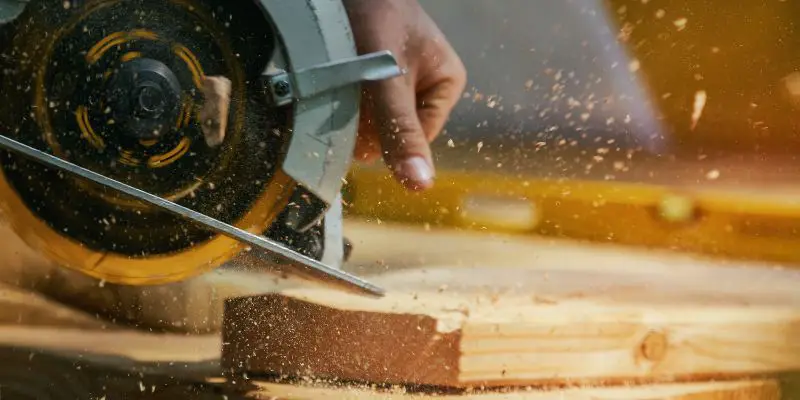To use a circular saw, first, ensure the blade is secured and the power is off. Then, measure and mark the material before guiding the saw along the cutting line for a clean cut.
Using a circular saw can be an efficient way to cut through various materials, such as wood, metal, or plastic. With the right technique, it can produce precise and smooth cuts, making it a versatile tool for DIY enthusiasts and professionals alike.
Whether you’re working on a woodworking project or tackling home renovations, understanding how to safely and effectively use a circular saw is essential. By following a few simple steps and precautions, you can maximize the potential of this powerful tool. In this guide, we will explore the key steps to operate a circular saw confidently and effectively.
Choosing The Right Circular Saw
When it comes to choosing the right circular saw, it’s important to consider several key factors to ensure that you have the right tool for the job. From power and size to corded vs. cordless options and blade types for different materials, making the right choice can greatly impact the outcome of your project.
Consider Power And Size
Power and size are crucial factors to consider when choosing a circular saw. The power of the saw is typically measured in amps, and higher amp models are better suited for heavy-duty cutting. Additionally, it’s important to consider the size of the saw, as a larger blade diameter generally allows for deeper cuts.
Corded Vs. Cordless Options
When choosing a circular saw, you’ll need to decide between corded and cordless options. Corded saws typically provide consistent power, making them suitable for longer, more demanding jobs. On the other hand, cordless saws offer greater mobility and are ideal for jobs in locations without easy access to power outlets.
Blade Types For Different Materials
The type of blade you choose for your circular saw will depend on the materials you plan to cut. Different blades are designed for cutting wood, metal, masonry, and other materials. It’s essential to select the appropriate blade for the task at hand to ensure clean and efficient cuts.

Preparing Your Work Area
When it comes to using a circular saw, preparing your work area is essential to ensure safety and efficiency. By following a few key steps, you can create a work environment that minimizes risks and maximizes your ability to complete your project successfully. This includes wearing appropriate safety equipment, securing your workpiece properly, and setting up adequate lighting and workspace. Let’s take a closer look at each aspect of preparing your work area when using a circular saw.
Safety Equipment And Attire
Prior to starting your project, it’s crucial to equip yourself with the necessary safety gear. This includes wearing protective goggles to shield your eyes from potential debris, ear protection to guard against the loud noise emitted by the saw, and gloves to maintain a secure grip on the tool and protect your hands. Additionally, wearing appropriate attire, such as long pants and a long-sleeved shirt, can provide an extra layer of protection against flying wood chips and sawdust.
Securing Your Workpiece Properly
Before beginning any cutting operation, it’s imperative to secure your workpiece to prevent it from shifting or moving during the cutting process. Use clamps or vises to firmly hold the material in place, ensuring that it remains steady and stationary throughout the sawing procedure. By taking this precaution, you can decrease the risk of accidents and achieve precise, accurate cuts.
Adequate Lighting And Workspace Setup
Ensure that your work area is well-lit to provide optimal visibility during the cutting process. Utilize overhead lighting or portable work lights to illuminate the cutting line and surrounding area. Furthermore, organize your workspace to allow for unobstructed movement and easy access to the material being cut. Keep the workspace clean and uncluttered, eliminating any potential tripping hazards and creating a clear, safe environment for operating the circular saw.
Expert Tips For Accurate Measurements
Accurate measurements are crucial when using a circular saw to ensure the precision and quality of your cuts. Mastering the art of measuring and marking the workpiece, setting up the saw guide for straight cuts, and ensuring precision in repeated cuts can significantly enhance the outcome of your woodworking projects. Here are some expert tips to help you achieve precise measurements and cuts with your circular saw.
Measuring And Marking The Workpiece
Before making any cuts with a circular saw, it’s essential to measure and mark the workpiece accurately. To achieve precise measurements, use a high-quality tape measure or ruler to determine the desired length and width of the material. Mark the cut line clearly using a pencil or marking knife, ensuring the line is straight and visible.
Setting Up The Saw Guide For Straight Cuts
For straight cuts, using a saw guide is essential to maintain accuracy throughout the cutting process. Ensure that the saw guide is securely positioned along the marked cut line, and adjust it as necessary to achieve a straight path for the circular saw. Secure the saw guide firmly to prevent any deviation while cutting, and double-check the alignment before initiating the cut.
Ensuring Precision In Repeated Cuts
When making multiple cuts of the same measurements, it’s crucial to maintain consistency and precision. To ensure accuracy, use clamps to secure the workpiece and saw guide firmly in place before each cut. Measure and mark each piece separately to account for any variations in material dimensions, and inspect the alignment of the saw guide before proceeding with each cut.
By implementing these expert tips for accurate measurements, you can enhance the precision and quality of your cuts when using a circular saw. Prioritizing precise measurements and meticulous attention to detail will significantly contribute to the success of your woodworking projects.

Advanced Techniques For Complex Cuts
When it comes to using a circular saw, mastering the advanced techniques for complex cuts can significantly enhance the precision and efficiency of your projects. Whether you’re dealing with bevel cuts, plunge cuts, or wide panels, understanding these advanced techniques can take your woodworking skills to the next level.
Making Bevel Cuts With Precision
Bevel cuts are essential for creating angled edges in various woodworking projects. To make accurate bevel cuts with a circular saw, ensure that the blade is properly adjusted. Then, use a combination square to set the desired angle, and carefully guide the saw along the marked line. Always practice on scrap material before making the actual cut to ensure precision.
Using A Circular Saw For Plunge Cuts
Plunge cuts are useful for creating interior cutouts in the middle of a workpiece. To perform a plunge cut, start by marking the area to be cut. Then, carefully lower the spinning blade onto the workpiece and steadily guide the saw through the cut. Remember to use a ruler or straight edge to maintain a straight cut line, and always wear appropriate safety equipment when making plunge cuts.
Techniques For Cutting Wide Panels
When it comes to cutting wide panels, ensuring stability and accuracy is crucial. Consider using a support or sawhorse to provide additional stability and support for the panel. Utilize a guide rail or straight edge to help maintain a straight and precise cut along the entire length of the panel. Additionally, using a clamping guide can help prevent the panel from shifting during the cut, resulting in a clean and accurate end product.
Circular Saw Upkeep For Optimal Performance
Proper upkeep of your circular saw is crucial to ensure its optimal performance and longevity. By following a regular maintenance routine, sharpening or replacing the blade when necessary, and troubleshooting common issues, you can maximize the efficiency and safety of your tool. Here’s how you can keep your circular saw in top condition.
Regular Cleaning And Maintenance Routine
Regular cleaning and maintenance are essential for the proper functioning of your circular saw. It is recommended to clean the saw after each use to remove sawdust, dirt, and debris that can accumulate and affect its performance. Use a soft brush or compressed air to clean the motor vents, blade guard, and base plate. Additionally, lubricate the blade depth adjustment mechanism and check for any loose screws or parts that may need tightening.
Blade Sharpening And Replacement
The sharpness of the blade greatly impacts the quality of cuts and the overall performance of the saw. Regularly inspect the blade for signs of wear, dullness, or damage. If the teeth are dull or chipped, sharpen the blade using a file or replace it with a new one to ensure precise and clean cuts. Properly installing and aligning the new blade is essential for safety and efficient cutting.
Troubleshooting Common Issues
Common issues such as motor overheating, blade binding, or inaccurate cuts can hinder the performance of your circular saw. Check the power supply, motor vents, and blade alignment to prevent overheating and ensure smooth operation. If the blade is binding or producing rough cuts, inspect the condition of the blade and make necessary adjustments. Additionally, always follow the manufacturer’s guidelines for troubleshooting specific issues to avoid further damage to the saw.
Frequently Asked Questions For How To Use A Circular Saw
What Safety Gear Do I Need For Using A Circular Saw?
Safety gear for using a circular saw includes protective goggles, ear muffs, and work gloves. Make sure to wear appropriate clothing and sturdy footwear to protect against any potential injuries.
How Can I Make Accurate Cuts With A Circular Saw?
To make accurate cuts with a circular saw, use a straight edge guide or a clamped-on board as a guide. Measure and mark the cutting line carefully before starting. Ensure that the saw blade is aligned with the cutting line for precision.
What Maintenance Does A Circular Saw Require For Optimal Performance?
Regular maintenance of a circular saw involves keeping the blade sharp and clean. Additionally, lubricate the blade shaft and check for any loose parts. Clean the saw after use and store it in a dry place to prevent rusting.
Conclusion
Mastering the use of a circular saw requires practice and patience. By following safety protocols and understanding the correct techniques, you can confidently tackle various cutting projects. With these guidelines in mind, you can enhance your woodworking skills and achieve precise, professional results with a circular saw.


